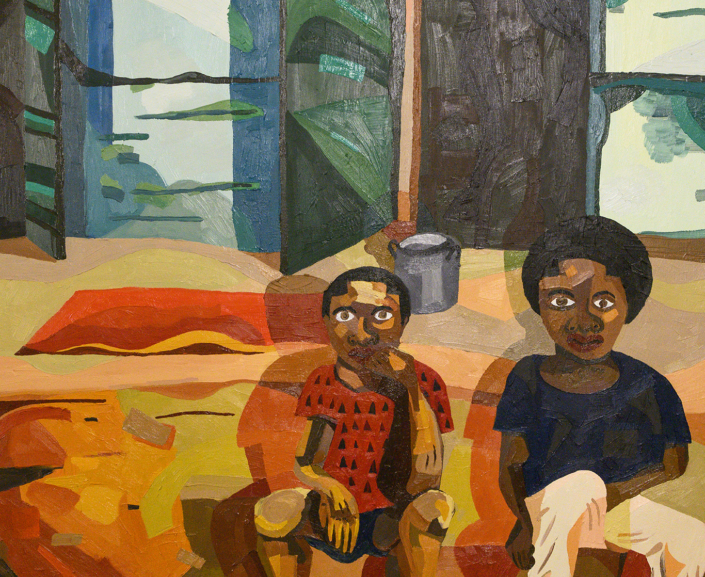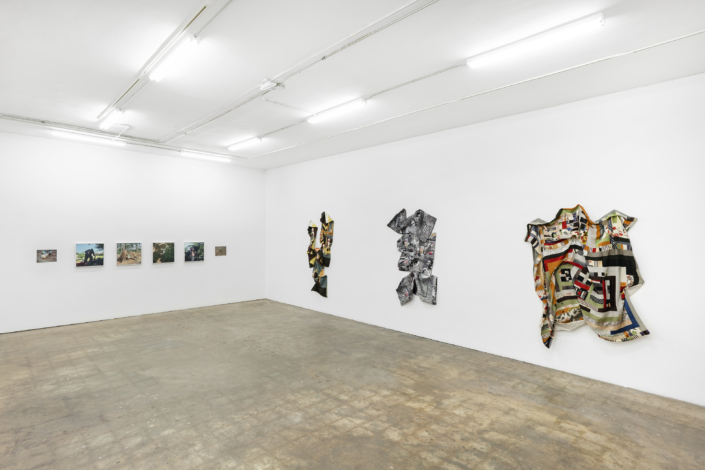RECEPTION
SATURDAY, March 2, 6 – 9 PM
THE ARTIST WILL BE PRESENT
I am my story
“There is no story that is not true.” ― Chinua Achebe, Things Fall Apart
Mindy Solomon Gallery is pleased to introduce to Miami four artists working within the narrative genre. Story telling through the media of photography, painting, and textile, each artist brings a level of authenticity, high craftsmanship and sincerity to their chosen medium.
Whether originally from the United States, or resettled, or living abroad, the origins of their personal mythology are critical elements in their work. The history of spoken word and visual documentation goes back to biblical times and the beginnings of human beings in the Great Rift Valley. The Rift Valley is a contiguous geographic trench that runs from Lebanon’s Beqaa Valley in Asia to Mozambique in Southeastern Africa. This region is known as the cradle of civilization.
In our ongoing quest to better understand our place in the universe, we need to reconnect to the birthplace of our shared origins. As our world becomes increasingly more interconnected and information passes between communities faster then can be confirmed or verified, dialog becomes increasingly important. It is with this intention that we present works that facilitate an ongoing conversation about who we are….and why.
Azikiwe Mohammad is a New York based artist. Born is 1983 and a graduate of Bard College in 2005, Mohammed began his artistic journey in New York City. A Renaissance man of sorts, he works in painting, photography, sculpture and music, as his persona, DJ Black Helmet. Mohammed’s interdisciplinary practice is grounded by a deep technical facility with photography and an interest in archiving. His artistic endeavors center around world-building, though installations encompassing painting, sculpture, sound, and performance, based on the town of New Davonhaime, a fictional safe community for black and brown people inspired by stories collected from friends and strangers.
When discussing his work, Mohammed states:
“By re-contextualizing well defined and documented ideas / display methods traditionally attributed to white people and their accompanying history I hope to offer a different look or starting point for a current conversation about black history / people. Both the black race and the white race are American constructs that are maintained to protect white interests. If these two races / ideas are constructs, than is the history based on these things a construct as well? Is this history as malleable as the lies we are fed in retellings of events passed? What if we were given a different starting point? What if the language that has been developed to talk about whiteness was used to describe blackness? What would that look like? Once placed back in their appropriate historical context do these new images carry the same message? I am still not sure of an answer but I am working to find out.”
Hellen Gaudence is a NYC-based photography and video artist working between her home country, Tanzania and the United States. Gaudence’s journey in the US began in 2015: “In 2015, my immigration status changed from student to U.S. permanent resident through a random selection of the Diversity Visa Lottery. Consequently, I began to think about the external influencers, which instigate movement over the self- such as politics, physical environment, and even chance and ultimately our negotiations in response. My work centers around the experiences of African-born migrants resettled in the United States; specifically, the interaction between identity, memory, and place. While living in Tucson Arizona—where my immigration paperwork was officiated—I encountered African migrants each with their own unique experience and motivation for departing Africa and resettling in the small quaint western town.
Through their stories, my ideas concerning place began taking shape. This became the project Magharibi—Swahili for the navigation point west of the sun. Particularly with this work, I am exploring the process of place-making within a non native space by underscoring absence.” Beyond it being just a physical location, place is a keeper of memories and experiences, to leave the familiar is to be absent of it. The scholar Yi-Fu Tuan writes “…Place, however, has more substance than the word location suggests: it is a unique entity, a special ensemble, it has history and meaning. Place incarnates the experiences and aspirations of a people.”
“Inspired by the historical portraiture work captured in western America such as Edward Curtis’s Native Americans, I responded with a 4 by 5 camera and made black and white portraits. These were then paired with color landscape images I shot while in my home country, Tanzania. The effect is a purposeful representation of Africa as a homogenous location, despite my sitters originating from Burundi, DRC, Eritrea, Ghana, Kenya, Liberia, Morocco, Nigeria, Rwanda, and Zimbabwe.”
Conrad Egyir was born in 1989 in Accra, Ghana. Heavily influenced by a rich art form of storytelling in West Africa, his creative practice borrows from a pool of uniquely coded text and visually based language systems from Ghana. In an exploration of relationships between his past experiences in Africa and his present residence in the United States, he is drawn to themes that define the then and the now, differences and similarities, and the image and the self. His practice analyzes the relationships between the semiotics and historicity of these themes that lie within his African postcolonial upbringing and Western higher education.
“I create narrative paintings and portraiture. Woven between the fabric of my narratives are borrowed superstitious and symbolic aesthetics from West Africa, anachronisms from different cultures, and a deconstruction and redefining of colorism and identity as defined by Western academia. One parameter of this creative practice is to use subjects that do not fit in the timelines or settings of the borrowed stories that I reprise or conjure. Adults, for example, would interchange with children, women with men, nobles with commoners, etc. The essence is to transcend the notions of each character’s perceived responsibility designated by age, sex, class, and race. The image of one’s self, as an immediate template of portraiture, is also often multiplied in my narrative paintings. Concurrently the singular image can become victim and perpetrator, father and son, friend and foe. It is a tool that behooves the viewer to simultaneously step into the shoes of the multiplicitous character, while questioning the relationships within the image and self, be it one’s mental faculties that war against each other or side with each other.”
Basil Kincaid was born in 1986, and is based in St. Louis. Kincaid is very philosophical regarding his approach to his art making practice.
“My family is my driving motivation and primary artistic influence. Quilting as a practice is saturated on both sides of my family dating back over 100 years. My immediate influence as a quilter is Eugenia Kincaid, my grandmother on my father’s side. She appears to me in dreams, guiding my hands as we collaborate a spiritual level. I strongly believe that Quilting opens a portal for me to exist with all of my ancestors that maintained the practice and potentially beyond. Upholding family traditions in the face of oppression is essential within my healing process. Quilting within the black cultural tradition has always served as a revolutionary space of joy, courage, and community in direct contrast to social and financial subjugation.
My stylistic approach is influenced by the innovations, practices, and cultural products of Black Americans, and West Africans. More specifically, I am interested in Black American folk and fine art, music, poetry, and family traditions.”
Each artists participating in I Am My Story is a by-product of rich cultural traditions. Drawing from history and geography, they bring a unique perspective to what it means to be fully engaged in their furthering their stories.
About the Artists
Conrad Egyir’s (born and raised in Ghana) creative practice draws from a pool of uniquely coded Ghanaian texts and visually based language systems. In an exploration of relationships between his past experiences in Africa and his present residence in the United States, he is drawn to themes that define the past and present, the image and self, and predestination and free will. His practice analyses the relationships between the semiotics and historicity of these themes as a grappling coalescence of postcolonial upbringing and western higher education.
Woven into his works are borrowed superstitious and symbolic aesthetics from West Africa, anachronisms from different cultures, and a deconstruction and redefining of colorism and identity as defined by Western academia. One parameter of this creative practice is to use subjects that do not fit in the timelines or settings of the stories Egyir draws from, often interchanging a character’s gender, social status, or age. Egyir often uses his own image as a template for his figures, making a singular image transcend a narrative – the individual becoming simultaneously the victim and perpetrator, father and son, friend and foe.
Conrad Egyir received a B.A. from Judson University, Elgin, IL for Studio Art (2015) and an M.F.A in Painting from Cranbrook Academy of Art Bloomfield Hills, MI (2018). He has been an artist in residence at Vermont Studio Center, in VE (2018), ACRE, in WI (2018), Ox-Bow (2018), and Talking Dolls in Detroit, MI (2017). During his graduate education he worked as an art instructor with ArtRoad, a nonprofit organization sponsored by Mercedes-Benz, that revives art education in Detroit public schools where it was once deprogrammed due to lack of funding.
Hellen Gaudence is a NYC-based photography and video artist working between her home country, Tanzania and the United States. Her work draws upon autobiographical narrative and historical memory in response to issues concerning identity, migration and present day construction of the African Diaspora. Hellen has exhibited and presented her work within the U.S, Mexico, and Tanzania. She holds a Master of Fine Art degree from the University of Arizona.
Basil Kincaid, b. 1986, is an emerging, Post-Disciplinary Visual Artist based in St. Louis, Missouri. Kincaid Studied studio art at Colorado College graduating in 2010 with a concentration in Studio art with emphasis on drawing and painting. Kincaid has exhibited work in St. Louis, Los Angeles, Miami, Chicago, Boca Raton, Boston, New York, Montpellier France and Accra Ghana. Basil Kincaid was the inaugural Artist In Residence at JP Morgan and has four works in their permanent collection. Kincaid attended The Fountainhead Residency in Miami in 2017. In 2014-15 Kincaid was the inaugural recipient of the Arts Connect International, Artist in Residence Program.
Azikiwe Mohammed graduated from Bard College in 2005 where he studied photography and fine arts. Since then he has shown these things in galleries both nationally and internationally. In 2015 he received the Art Matters Grant, and in 2016 was the recipient of the Rema Hort Mann Emerging Artist Grant. He is an artist-in-residence alumnus of Pioneer Works in Brooklyn, New York, Kickstarter in Brooklyn, New York and Mana Contemporary in Jersey City. His work has been featured extensively in the media, including VICE, I-D Magazine, Artforum, BOMB Magazine, and Hyperallergic. Mohammed has presented a number of solo exhibitions including The Knockdown Center, Maspeth, NY; Long Gallery, Harlem, NY; The Ace Hotel Chicago, Chicago, IL; Rush Arts, NY; as well as multiple solo offerings at Spring Break Art Fair in New York City. He has participated in group exhibitions at MoMa PS1, Queens, NY; Antenna Gallery, New Orleans, LA; Charlie James Gallery, Los Angeles, CA and the Studio Museum In Harlem, New York, NY among others. He lives in New York and currently has his studio at Mana Contemporary as part of their mana BSMT program.




















